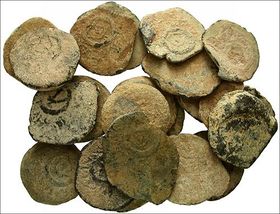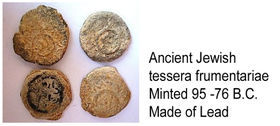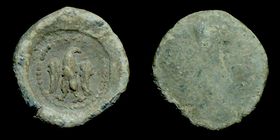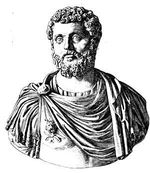Tesserae

These tokens known as tesserae, meaning "tile". They were evidence of your entitlements but also of your entanglements under Roman authority of the Roman world.

As a means of identification the original parties exchanged or displayed these tokens or tesserae hospitālēs.
In the Obligations of Hospitium there are obligations imposed by a covenant were of the most sacred character, and any failure to regard its provisions was considered sacrilege, bringing upon the offender, the anger of Iuppiter Hospitālis..
These ties were hereditary, descending from father to son, so that persons might be hospitēs who had never so much as seen each other, whose immediate ancestors even might have had no personal intercourse. As a means of identification the original parties exchanged tokens tesserae hospitālēs.[1]
The tessera hospitalis was the token of mutual hospitality, and is spoken of under Hospitium, p619A. This token was probably in many cases of earthenware, having the head of Jupiter Hospitalis stamped upon it.[2]
When a stranger claimed hospitium his tessera had to be produced and submitted for examination. If it was found to be genuine, he was entitled to all the privileges that the best-known guest-friend could expect.
"This same systems was use to provide government welfare. It is clear that these are almost precisely the duties an practices devolving upon members of our own great benevolent societies at the present time when appealed to by a citizen in distress."[3]
There has always been two basic Welfare types in societies throughout history. They often are a key to sealing the fate of society an nations.
These clay tiles that became a titulus in a welfare state were not a new thing to Romans. A tessera was the ancient Roman equivalent of a theater ticket. Stamped into a clay shard was an entrance aisle and row number for spectators attending an event at an amphitheater or arena. Above the doors of the Colosseum in Rome are numbers corresponding to those stamped into a spectator's tessera.

Tesserae frumentariae and nummariae were tokens given at certain times by the Roman magistrates to citizens, in exchange for which they received a fixed amount of wheat or money.[4]
TES′SERA, dim. TESSE′RULA and TESSEL′LA (κύβος), a square or cube; a die; a token. "a small tablet (as of wood, bone, or ivory) used by the ancient Romans as a ticket, tally, voucher, or means of identification[2] "

The Roman symbol was the eagle and they used these tiles for centuries for many purposes. But as the citizens became more and more dependent and enfranchised "The Roman Empire used tiles called tesserae to identify slaves, soldiers, and citizens over 2,000 years ago."[3]
Tessera frumentariae and nummariae were tokens given at certain times by the Roman magistrates to the poor, in exchange for which they received a fixed amount of cornº or money (Sueton. Aug. 40, 42, Nero, 11).
Frumentariae Leges. Similar tokens were used on various occasions, as they arose in the course of events. For example, when the Romans sent to give the Carthaginians their choice of peace or war, they sent two tesserae, one marked with a spear, the other with a Caduceus, requesting them to take either the one or the other (Gellius, X.27). From the application of this term to tokens of various kinds, it was transferred to the word used as a token among soldiers. This was the tessera militaris, the συνθημα of the Greeks. Before joining battle it was given out and passed through the ranks as a method by which the soldiers might be able to distinguish friends from foes. Thus at the battle of Cunaxa the word was "Zeus the Saviour and Victory," and on a subsequent engagement by the same troops "Zeus the Saviour, Heracles the Leader" (Xen. Anab. I.8 §16, VI.3 §25).
The soldiers of Xenophon used a verbal sign for the same purpose when they were encamped by night (VII.3 §34). Aeneas Tacticus (c24) gives various directions necessary to be observed respecting the word. Respecting the tessera or watchword in the Roman camp, see Castra, p251A .
This is all to identify i you are loyal, a member who serves with others within a single body of soldiers or a body politic.
Charagma
"The Roman government under Augustus had already been issuing (inscribed ) Tesserae (tiles) as proof of entitlement to the periodic grain doles.[5]"[6]
In the time of Caligula there is a record of the people providing what would be called in Greek a charagma. A chragma was required by the time of Nero to do business in the market place but before him we know that Claudius had exiled many Jews because of their lack of cooperation and trouble making.
What kind of trouble and what kind of Jew?
Christians for the most part were considered Jews. They claimed a king of the Jews[7] as their king and often did contrary to the decrees of Caesar.[8] Claudius had exiled many of them from Rome.[9]
Why would you have one of these state issued charagmas?
So you could get benefits as members of a system of Qorban that provided social welfare.
Caligula before Claudius in AD 37-41 almost bankrupted the system of Qorban in Rome and Pontius Pilate took funds out to build an aqueduct at Jerusalem in Judea and caused a riot.
Those who paid into the emperor's system of Qorban received a certification that they were members of that system. By the reign of Emperor Decius AD 250), those who their proof of sacrifice to Caesar could be excluded from the market place. During this time they had price controls and sales tax and identification was essential for enforcement.
The system of Qorban was at the center of the Roman/Christian conflict. It was also at the center of the conflict between Christ and the Pharisees whose system of Corban made the word of God to non effect.[10]
- Our modern ideas of religion differ from the meaning of the word in the days the Bible was written. Pure religion was a religion rooted in charity alone.
- Celsus, a Platonist, writing during the term of Marcus Aurelius, “opposed the ‘sectarian’ tendencies at work in the Christian movement because he saw in Christianity a ‘privatizing’ of religion, the transferal of religious values from the public sphere to a private association.”

- This persecution which began under the Emperor Septimius Severus:
- "Severus returned victorious from having vanquished the kings who had taken part with Nigar against him, he published his cruel edicts against the Christians in the year of Christ 202, the tenth of his reign. But the general laws of the empire against foreign religions, and the former edicts of several emperors against the Christians, were a sufficient warrant to many governors to draw the sword against them before that time; and we find that the persecution was very hot in Africa two years before, under the proconsul Saturninus..." [12] See Christian conflict
Christians believed all kinds of things about God and the afterlife etc. Jesus said little bout that but he was clear that you could not be Benefactors like the gentiles who exercised authority one over the other and forced the contributions of the people.
The position should be clear that the mark or badge of the beast that proves you must bow down and serve the beast comes in many forms. It will make things difficult so that you can hardly buy or sell in the market place if you do not have the badge of service.
This has happened off and on throughout the ages and is happening again.
For a more detailed look at what Revelation real says go to: http://www.hisholychurch.org/sermon/mark2.php
In Strong’s. “5480 charagma, χαράγμα, khar-ag-mah; did include a graven mark. Strong’s concordance translated mark (8) - graven (1) is defined 1a) a stamp, an imprinted mark: of the mark stamped on the forehead or the right hand as the badge of the followers of the Antichrist; the mark branded upon horses.
A Charagma appeared in many forms and for many purposes but most often to identify someone or something as property or wards and servants who owed service "i.e. stamp (as a badge of servitude)". It could even just be in writing like a charagmati χαράγματι and serve the same purpose.
Charagma vs CardSee [4]
10/29/2012 A discussion on the thirteenth chapter of the book, The Covenants of the gods, titled Charagma vs. Card. The Charagma is a Greek word that represented the badge of servitude yesterday, whereas the Card is the badge of servitude today. The book of Revelation says that to buy or sell people will need to have or hold this mark or charagma.
Audio
http://www.hisholychurch.net/kkvv/cog13CharagmavsCard56.mp3
Footnotes
- ↑ see Rich and Harper, s. v.
- ↑ Plaut. Poen. V.1.25; 2.87‑99).
- ↑ THE PRIVATE LIFE OF THE ROMANS BY HAROLD WHETSTONE JOHNSTON PROFESSOR OF LATIN IN THE INDIANA UNIVERSITY CHICAGO SCOTT, FORESMAN AND COMPANY 1909
- ↑ Smith, Sir William (1859), A dictionary of Greek and Roman antiquities (2 ed.), Little, Brown, and Co., p. 550 [1]
- ↑ Suetonius, Aug. 40.2 42.3
- ↑ The First Christians in the Roman World: Augustan and New Testament Essays, Page 425, By E. A. Judge. Mohr Siebeck, Jan 1, 2008 - Religion - 786 pages.
- ↑ Luke 23:38 And a superscription also was written over him in letters of Greek, and Latin, and Hebrew, THIS IS THE KING OF THE JEWS. John 19:19 ¶ And Pilate wrote a title, and put [it] on the cross. And the writing was, JESUS OF NAZARETH THE KING OF THE JEWS.
- ↑ Acts 17:7 Whom Jason hath received: and these all do contrary to the decrees of Caesar, saying that there is another king, [one] Jesus.
- ↑ Acts 18:2 And found a certain Jew named Aquila, born in Pontus, lately come from Italy, with his wife Priscilla; (because that Claudius had commanded all Jews to depart from Rome:) and came unto them.
- ↑ Mark 7:11 But ye say, If a man shall say to his father or mother, [It is] Corban, that is to say, a gift, by whatsoever thou mightest be profited by me; [he shall be free]. And ye suffer him no more to do ought for his father or his mother; Making the word of God of none effect through your tradition, which ye have delivered: and many such like things do ye.
- ↑ Christians as the Romans Saw Them, by Robert Wilken page 125.
- ↑ The Lives of the Saints. Volume VII: July. 1866. Rev. Alban Butler (1711–73).